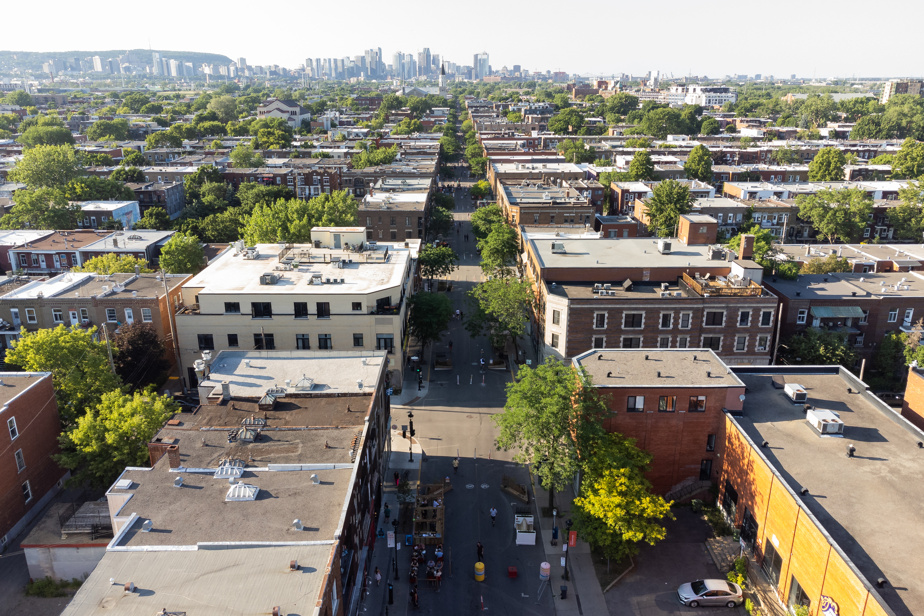(Montreal) Wellington Street, in the Verdun borough of Montreal, is booming, with its beautiful storefronts lining a lively pedestrian neighborhood.
With a commercial vacancy rate that the neighborhood’s business association estimates at around 6%, Time Out magazine’s “coolest street in the world” in 2022 is a success in the City’s fight against empty storefronts that plague several main arteries of Montreal.
Marie-Ève Girard, business development advisor at the Wellington Commercial Development Corporation (SDC), said Wellington Street benefited not only from the influx of tourists following the Time Out magazine ranking, but also from aspects of the COVID-19 pandemic, which prompted citizens of Verdun to explore their local streets.
“Because people were at home, they rediscovered their neighborhood,” she explained in a telephone interview. There was also a huge enthusiasm for buying local. »
To further stimulate demand, the SDC rents, one month at a time, a formerly vacant storefront to entrepreneurs eager to test the neighborhood’s business environment.
However, the situation is not the same everywhere. Across Montreal, the storefront vacancy rate stands at 13.1%, according to the City’s open data portal, a slight drop from 15% in 2019, when the administration has launched public consultations on the issue.
“The fact that there are no more vacant storefronts than before, despite the fact that we had a pandemic, is excellent news,” Luc Rabouin, president of the Montreal executive committee, recently declared. , in interview.
Many streets reported fewer empty stores after renovations to make them more attractive, he said. The vacancy rate along Avenue du Mont-Royal in the Plateau neighborhood fell from 14.5% in 2018 to 5.6% this year, after the street was closed to automobile traffic and redeveloped to add seating and greenery.
On the other hand, downtown has suffered from the loss of foot traffic due to the increase in remote working caused by the pandemic – a situation that all major cities are facing, Mr. Rabouin said.
Representatives of several local business development groups, SDCs, report falling vacancy rates, even as high inflation and rumors of recession threaten their post-pandemic recovery.
Even rue Saint-Denis, long plagued by empty storefronts, saw its vacancy rate drop from 24% in 2020 to around 16%, according to the general director of the SDC rue Saint-Denis, Julien Vaillancourt Laliberté.
Mr. Vaillancourt Laliberté indicated that things are going “rather well” thanks to the end of major road works, the completion of the Réseau express vélo (REV) in Saint-Denis and provincial funds to help city centers to recover from the pandemic. The street is also one of the few to allow residents to rent their homes on short-term rental platforms, such as Airbnb.
Mr. Vaillancourt Laliberté and Patrick Legault, president of the SDC of Hochelaga-Maisonneuve, affirm that one of the challenges in further reducing the vacancy rate is the presence of storefronts that have been closed for a long time, often in poor condition, and that the owners do not wish to rent.
“In general, the owners are happy to talk to us, to have us organize meetings and to meet possible tenants, but some… simply leave their buildings,” said Mr. Legault. The part of Ste-Catherine Street that he supervises has a vacancy rate of 14%, partly due to buildings too abandoned to be occupied.
The city introduced new rules requiring owners of vacant buildings to register them with the city and meet higher maintenance standards or face fines. Business association groups welcome the rules, but say it’s unclear whether the city will enforce them.
Even on Wellington Street, everything is not rosy. A “For Rent” sign sits in the window of Boutique Sauvé, also known as JayMart, which is closing its doors after more than 100 years. Owner Amit Natalia says the main reason for closing is his health, but he adds that business is tougher now than at any time he can remember.
“With COVID and the economy, people don’t have money, they don’t spend money,” lamented the 67-year-old.
Girard said the street is not resting on its laurels. Ultimately, there is a chance that it will become a victim of its own success, as building owners raise commercial rents and thus force tenants out. The difficult economic situation is even more pressing as people spend less.
“Our street is doing well, but we always remain vigilant,” she said.
SDCs across the city work with their boroughs to organize events, including a comic book festival on Saint-Denis Street, and an outdoor sugar shack and giant puppets on Wellington Street. In Ville-Marie, artists, businesses and non-profit organizations can apply for a permit to temporarily occupy a vacant store.
Attracting in-person customers in the age of online shopping requires not only having goods to sell, but also creating a unique experience, Vaillancourt Laliberté said.
“Are we going to stay at home, take out the credit card to buy something delivered to our door without human warmth, without transmission of values, without emotional connection to our street?,” he said. I think [this experience] is what people want. »
